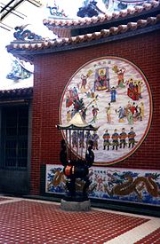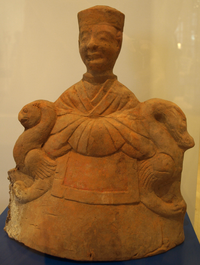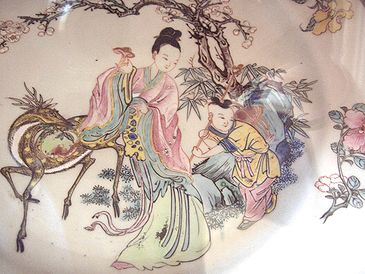
Xi Wangmu
Encyclopedia

Her official Taoist title is Yaochi Jinmu (瑤池金母), or the Golden Mother of the Shining Lake. Historical (T'ang dynasty) biographers name her: Chin mu yüan chün, The Primordial Ruler, Metal (Gold) Mother; Metal (Gold) Mother of Tortoise Mountain, She of the Nine Numina
Numina
Numen is a Latin term for a potential, guiding the course of events in a particular place or in the whole world, used in Roman philosophical and religious thought...
and the Grand Marvel; and the Perfected Marvel of the Western Florescence and the Ultimate Worthy of the Grotto Yin. Commoners and poets of the T'ang dynasty referred to her more simply as Queen Mother; Divine Mother; or by the ancient, familiar expression for "mother" or "nanny", Amah. In modern times she is often called Wángmŭ Niángniang (王母娘娘).
History
The first mentions of the Queen Mother date back to the oracle bone inscriptions of the Shang Dynasty (1766-1122 B.C.).One inscription reads:
- "Crack-making on day IX,9 day; we divined. if we make offering to the eastern mother and the western mother, there will be approval.'"
Western Mother refers to an archaic divinity residing in the west. The exact nature of the Mother divinities in the Shang dynasty is unclear, but they were seen as powerful forces deserving of ritual by the people of the Shang dynasty.
Originally, from the earliest known depictions of her in the "Guideways of Mountains and Seas" during the Zhou Dynasty
Zhou Dynasty
The Zhou Dynasty was a Chinese dynasty that followed the Shang Dynasty and preceded the Qin Dynasty. Although the Zhou Dynasty lasted longer than any other dynasty in Chinese history, the actual political and military control of China by the Ji family lasted only until 771 BC, a period known as...
, she was a ferocious goddess
Goddess
A goddess is a female deity. In some cultures goddesses are associated with Earth, motherhood, love, and the household. In other cultures, goddesses also rule over war, death, and destruction as well as healing....
with the teeth of a tiger
Tiger
The tiger is the largest cat species, reaching a total body length of up to and weighing up to . Their most recognizable feature is a pattern of dark vertical stripes on reddish-orange fur with lighter underparts...
, who sent Pestilence
Infectious disease
Infectious diseases, also known as communicable diseases, contagious diseases or transmissible diseases comprise clinically evident illness resulting from the infection, presence and growth of pathogenic biological agents in an individual host organism...
down upon the world. After she was adopted into the Taoist pantheon, she was transformed into the goddess of life and immortality.
Zhuangzi
One of the earliest written references to the Queen Mother comes from the writings of the Taoist writer ZhuangziZhuangzi
Zhuangzi was an influential Chinese philosopher who lived around the 4th century BCE during the Warring States Period, a period corresponding to the philosophical summit of Chinese thought — the Hundred Schools of Thought, and is credited with writing—in part or in whole—a work known by his name,...
(c. 4th century BC):
- "The Queen Mother of the West obtained it..." (_the Dao) "..._and took up her seat at Shao kuang. No one knows her beginning; no one knows her end." (Benard, 2000)
Zhuangzi describes the Queen Mother as one of the highest of the gods, meaning she had gained immortality and celestial powers. Zhuangzi also states that Xiwangmu is seated upon a spiritual western mountain range, suggesting she is connected to not only the heavens but also to the west.
Mythological accounts of the Queen Mother in the T'ang Dynasty
During the T'ang dynasty (June 18, 618-June 4, 907) Poetry flourished throughout China (this period is commonly known as the "Golden age of Chinese poetry"). It was during this period that the Queen Mother became an extremely popular figure in poetry. Her mythology was recorded in the poems of the Chuan Tang Shih, ("Complete Tang Poetry")Quantangshi
The Quantangshi , and also translated as the Complete Tang Poems, is a collection of Tang poetry...
a collection of surviving poems (of an estimated 50,000 written during the period) from the T'ang dynasty.
After the fall of the T'ang dynasty, (around 910 - 920) a Shang ch'ing Daoist master and court chronicler named Tu Kuang - t'ing wrote a hagiographical biography of the queen mother as part of his text "Yung ch'eng chi hsien lu" ("Records of the Assembled Transcendents of the Fortified Walled City"). This account represents the most complete source of information about T'ang society's perceptions of Xīwángmǔ.
Iconography and Representation

She normally wears a distinctive headdress with the Peaches of Immortality suspended from it.
"Flourishing parasols, we reach the chronograms' extremity;
Riding on the mist, I wander to Lofty Whirlwind Peak.
The Lady of the Supreme Primordial descends through jade
interior doors;
The Queen Mother opens her Blue-gem Palace.
Celestial people-What a Crowd!
A lofty meeting inside the Cyan Audience Hall.
Arrayed Attendants perform Cloud Songs;
Realized intonations fill the Grand Empty Space.
Every thousand years, her purple crabapple ripens;
Every four kalpas, her numinous melon produces abundantly.
This music differs from that at the feast in the wilderness---
So convivial, and certainly infinite" (Wu Yun. CTS. 4942).
Encountering Legends
In Tu Kuang-t'ing's text, after Introducing Xiwangmu, he includes narrative accounts of the Queen Mother's encounters with legendary Chinese heroes. One such account narrates an encounter between the Queen Mother and Laozi (Note: The Laozi being referred to in the text is the god Lord Lao):
"In the 25th year of King Chao of the Chou dynasty (1028 BCE) ..."
"...Lord Lao and the realized person Yin Hsi went traveling..."
"...on their behalf, the Queen Mother of the West explicated
the Scripture of Constant Purity and Quiet." (CMYC, 24159)
In this account, Xiwangmu plays the role of Laozi's superior and is credited with the ultimate authorship of the Dao De Jing. This dichotomy of Xiwangmu as the superior is a characteristic of Shang Ch'ing Daoism, a Goddess worshiping sect of Daoism of which Tu Kuang-t'ing was a master. There is also an account of a meeting between Xiwangmu and Laozi in T'ang poetry (CTS , 1708.) this account however, being of traditional Daoist thought, has the Queen Mother taking an inferior role to Laozi, calling him "Primordial Lord" (the title of his highest manifestation) and pays homage to the sage.
The Queen Mother and Chinese Rulers

Yu the Great
The Xunzi, a 3rd century BCE classic of statecraft written by a follower of Confucius, wrote that "Yu studied with the Queen Mother of the West". This passage refers to Yu the Great, the legendary founder of the Xia dynastyXia Dynasty
The Xia Dynasty is the first dynasty in China to be described in ancient historical chronicles such as Bamboo Annals, Classic of History and Records of the Grand Historian. The Xia Dynasty was established by the legendary Yu the Great after Shun, the last of the Five Emperors gave his throne to him...
, and is pointing out that the Queen Mother of the West was Yu's teacher. It is believed that she grants Yu both legitimacy, and the right to rule, and the techniques necessary for ruling. (Bernard, 2000) The fact that she taught Yu gives her enormous power, since the belief in Chinese thinking is that the teacher automatically surpasses the pupil in seniority and wisdom.
King Mu of the Zhou Dynasty
Probably one of the best known stories of contact between a goddess and a mortal ruler is between King Mu of the Zhou Dynasty and the Queen Mother of the West. There are several different accounts of this story but they all agree that King Mu, one of the greatest rulers of the Zhou, set out on a trip with his eight chargers to the far western regions of his empire. As he obtains the eight chargers and has the circuit of his realm, it proves that he has the Mandate of Heaven. On his journey he encounters the Queen Mother of the West on the mythical Mount Kunlun. They then have a love affair, and King Mu hoping to obtain immortality, gives the Queen Mother important national treasures. In the end he must return to the human realm, and does not receive immortality. The relationship between the Queen Mother of the West and King Mu has been compared to that of Taoist master and disciple. (Bernard, 2000: 206) She passes on secret teaching to him at his request and he, the disciple, fails to benefit and dies like any other mortal.The First Emperor of the Qin Dynasty
The first emperor of the Qin Dynasty, Qin Shi Huang, united the Warring States of China through brilliant military strategy and diplomacy to control the greatest territory ever yet seen in China. It was also under his command that workers joined pre-existing sections of wall to create the Great Wall of China. Even after these accomplishments he is known in history as a failure both as a king and as a seeker of immortality. Qin had the opportunity to meet the Queen Mother of the West and attain greatness from her, but instead wasted it (Bernard, 2000:207) and died without the Mandate of Heaven or a dynasty. His story of not jumping at the chance to meet the Queen Mother serves as a warning to later men, as despite huge and costly efforts to pursue immortality; he died and speaks no more. The 9th century poet Zhunag Nanjie wrote:- "His flourishing breath once departed, he never more will speak;
- His white bones buried deep, the evening mountains turn cyan" (Quan Tangshi, 2836)
Emperor Wu of the Han Dynasty
As legend tells Emperor Wu of the Han Dynasty, Han Wudi the "Martial Emperor of the Han" and the Queen Mother of the West met during the height of Wu's reign, when she visited him during the night of Double Seven, the night for encounters between mortal men and divine women.(Bernard, 2000) When the Queen Mother of the West visits Emperor Wu she shares a banquet with him, grants him special teachings, and then departs. Emperor Wu just like King Mu before him fails to follow her teachings, and fails to put them into practice, and therefore he inevitably dies. The whole story of their meeting is described in Li Qi's long work the "Songs of the Queen Mother":
"The Martial Illustrious One fasted and observed abstinence in his Basilica for Receiving Florescence;
As he stood upright with folded hands, instantly the Queen Mother came to grant him an audience.
Rainbow standards numinously flashing: her qilin-drawn chariots,
With feathered parasols streaming and pheasant fans.
Her fingers holding intertwined pears, she sent them along for the emperor to eat;
By means of them one can prolong life and preside over the cosmos.
On top of her head she wore the nine-starred crown;
She led a flock of jade lads, then sat facing south.
"Do you want to hear my essential words? Now I'll report them to you."
The emperor thereupon burned incense and requested such a discussion.
"If you can rarefy you earth soul and dispatch the three corpses,
Afterward you will certainly have an audience with me at the Celestial
Illustrious One's palace."
Turning her head back, she told the servant girl, Dong Shuangcheng,
"The wind is finished; you may perform on the Cloud Harmony Mouth Organ."
Red auroral clouds and the white sun, in strict attendance, did not move;
Seven dragons and five phoenixes in variegated disarray greeted them.
How regrettable! He was too ambitious and arrogant; the divinities were not satisfied,
But sighed and lamented over his horses' hooves and chariots' wheel tracks.
In his covered walkways, song bells became hard to discern in the approaching evening;
In the deep palace, peach and plum flowers turned snowy.
Now I just look at my blue jade five-branched lamp;
Its coiled dragon spits fire as the light is about to be severed. (Quan Tangshi 750)
Xiwangmu and the Women of the T'ang
Because she was the embodiment of yin, highest goddess, and ruler of female Transcendents, The Queen Mother was seen to have had a special relationship with all women. In the beginning section of Tu Kuang-t'ing's hagiography, He lists the most important functions of the Queen Mother:- "In heaven, beneath heaven, in the three worlds, and in the ten directions,
- all women who ascend to transcendence and attain the way are her dependents." (CMYC)
The Queen Mother of the west was said to care for all women Daoists in the universe, both perfected and aspirants. T'ang writers frequently refer to her in poems about Daoist women. In accordance with the Shang Ch'ing vision expressed by Tu, she appears as teacher judge, registrar, and Guardian of female believers. Her forms reflect Tu's definitions.
The queen mother was held in especially high regard by Chinese women who did not represent the societal norm of the submissive woman. To these women, The Queen Mother of the West was seen as "a powerful, independent deity representing the ultimate yin controlling immortality and the afterlife." (Cahill, 1986).
Additional Readings
Wang, Robin. "Images of Women in Chinese Thought and Culture: Writings from the Pre-Qin Period through the Song Dynasty". Hackett Publishing Company. 2003Cahill, Suzanne E. "Transcendence & Divine Passion: The Queen Mother of the West in Medieval China", Stanford University Press. 1993.
300 T'ang poems. AFPC. http://www.afpc.asso.fr/wengu/wg/wengu.php?l=Tangshi
Further reading
- Zeisler, Bettina (2010). “East of the Moon and West of the Sun? Approaches to a Land with Many Names, North of Northern India and South of Khotan.” In: The Earth Ox Papers. Special Issue. The Tibet Journal, Autumn 2009 vol XXXIV n 3-Summer 2010 vol. SSSV n. 2. Edited by Roberto Vitali. Library of Tibetan Works and Archives, Dharamsala, H.P., India. pp. 371–463.

